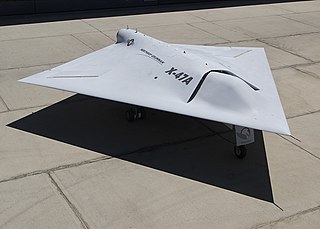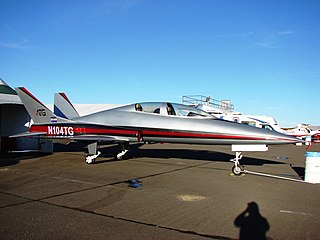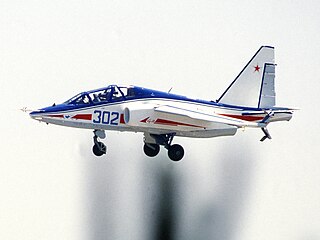
In aerodynamics, wing loading is the total mass of an aircraft or flying animal divided by the area of its wing. The stalling speed of an aircraft in straight, level flight is partly determined by its wing loading. An aircraft or animal with a low wing loading has a larger wing area relative to its mass, as compared to one with a high wing loading.

The Convair YB-60 was an early American prototype bomber aircraft for the United States Air Force.

The Dassault Étendard II was a French prototype fighter aircraft initially developed as a follow-on project to the Dassault Mystère series. It was presented to the French Air Force for evaluation but was rejected in favour of the Dassault Mirage III.

The McDonnell Douglas/General Dynamics A-12 Avenger II was a proposed American attack aircraft from McDonnell Douglas and General Dynamics. It was to be an all-weather, carrier-based stealth bomber replacement for the Grumman A-6 Intruder in the United States Navy and Marine Corps. Its Avenger II name was taken from the Grumman TBF Avenger of World War II.

The Boeing X-32 is a concept demonstrator aircraft that was designed for the Joint Strike Fighter competition. It lost to the Lockheed Martin X-35 demonstrator, which was further developed into the Lockheed Martin F-35 Lightning II.

The Bell XV-15 is an American tiltrotor VTOL aircraft. It was the second successful experimental tiltrotor aircraft and the first to demonstrate the concept's high speed performance relative to conventional helicopters.

The Northrop Grumman X-47 is a demonstration unmanned combat aerial vehicle. The X-47 began as part of DARPA's J-UCAS program, and is now part of the United States Navy's UCAS-D program to create a carrier-based unmanned aircraft. Unlike the Boeing X-45, initial Pegasus development was company-funded. The original vehicle carries the designation X-47A Pegasus, while the follow-on naval version is designated X-47B.

The Boeing Bird of Prey was a black project aircraft, intended to demonstrate stealth technology. It was developed by McDonnell Douglas and Boeing in the 1990s. The company provided $67 million of funding for the project; it was a low-cost program compared to many other programs of similar scale. It developed technology and materials which would later be used on Boeing's X-45 unmanned combat air vehicle. As an internal project, this aircraft was not given an X-plane designation. There are no public plans to make this a production aircraft. It is characterized as a technology demonstrator.

The Lockheed XB-30 was the design submitted by Lockheed after the request by the United States Army Air Forces for a very heavy bomber, the same request that led to the Boeing B-29 Superfortress, the Douglas XB-31 and Consolidated B-32 Dominator.

The ATG Javelin was an American small high-speed personal jet that was developed by the Aviation Technology Group (ATG) prior to its bankruptcy. Planned for FAA certification under 14 CFR part 23, the Javelin had a design resembling a fighter aircraft, an unusual concept for civilian jets. The Javelin MK-20 derivative, developed in cooperation between ATG and Israel Aerospace Industries, was expected to fill the jet trainer role for various air forces. The first prototype took flight on 30 September 2005, flown by retired Air Force 2nd Lt and test pilot Robert Fuschino.

The Martin XB-48 was an American medium jet bomber developed in the mid-1940s. It competed with the Boeing B-47 Stratojet, which proved to be a superior design, and was largely considered as a backup plan in case the B-47 ran into development problems. It never saw production or active duty, and only two prototypes, serial numbers 45-59585 and 45-59586, were built.

The Horten H.XVIII was a proposed German World War II intercontinental bomber, designed by the Horten brothers. The unbuilt H.XVIII represented, in many respects, a scaled-up version of the Horten Ho 229, a prototype jet fighter. The H.XVIII was one of many proposed designs for an Amerikabomber, and would have carried sufficient fuel for transatlantic flights. The XVIIIA variant, with its wood structure, buried engines in the fuselage, flying wing design and carbon-based glue component, would have been, in theory, the first stealth bomber in history.

The Myasishchev VM-T Atlant was a variant of Myasishchev's M-4 Molot bomber, re-purposed as a strategic-airlift airplane. The VM-T was modified to carry rocket boosters and the Soviet space shuttles of the Buran program. It is also known as the 3M-T.

The Boeing CC-137 was a transport and tanker aircraft which served with the Canadian Forces from 1970 to 1997. The Boeing 707-347C aircraft provided long range passenger transport for the military, VIP transport for government and air-to-air refueling for fighters such as the CF-116 Freedom Fighter and CF-18 Hornet. It was replaced by the Airbus CC-150 Polaris in the transport role and much later in the tanker role.

The Sukhoi Su-28 is a downgraded variant of the Su-25UB / Su-25T, with reductions in avionics and aircraft systems, together with the elimination of all weapon-carrying capability. The Su-28 trainer is intended for technical skill, general flight and formation flying training. It is also used as an aerobatic aircraft.

The Beriev Be-2500 Neptun is a super heavy amphibious transport aircraft that, as of 2007, was in design and development by Russian design firm Beriev. The maximum takeoff weight is estimated at 2500 tons, hence its name.

The McDonnell 119/220 is a business jet developed and unsuccessfully marketed by McDonnell Aircraft in the late 1950s and early 1960s. Its configuration is unique for this type of aircraft, with four podded engines underneath a low wing. It is the only airplane built by McDonnell Aircraft to be marketed to civil buyers prior to the company's merger with Douglas Aircraft to form McDonnell Douglas. The jet could be outfitted for 10 passengers in a luxury executive configuration and could carry as many as 29.

The Bradley BA 100 Aerobat is an American aerobatic homebuilt aircraft that was designed and produced by Bradley Aerospace of Chico, California. When it was available the aircraft was supplied as a kit for amateur construction.
The Boeing Model 8, a.k.a. BB-L6, was an American biplane aircraft designed by Boeing specifically for their test pilot, Herb Munter.
The SIPA S.70 was a late 1940s French eight-passenger light transport aircraft prototype built by Société Industrielle Pour l’Aéronautique (SIPA).

















